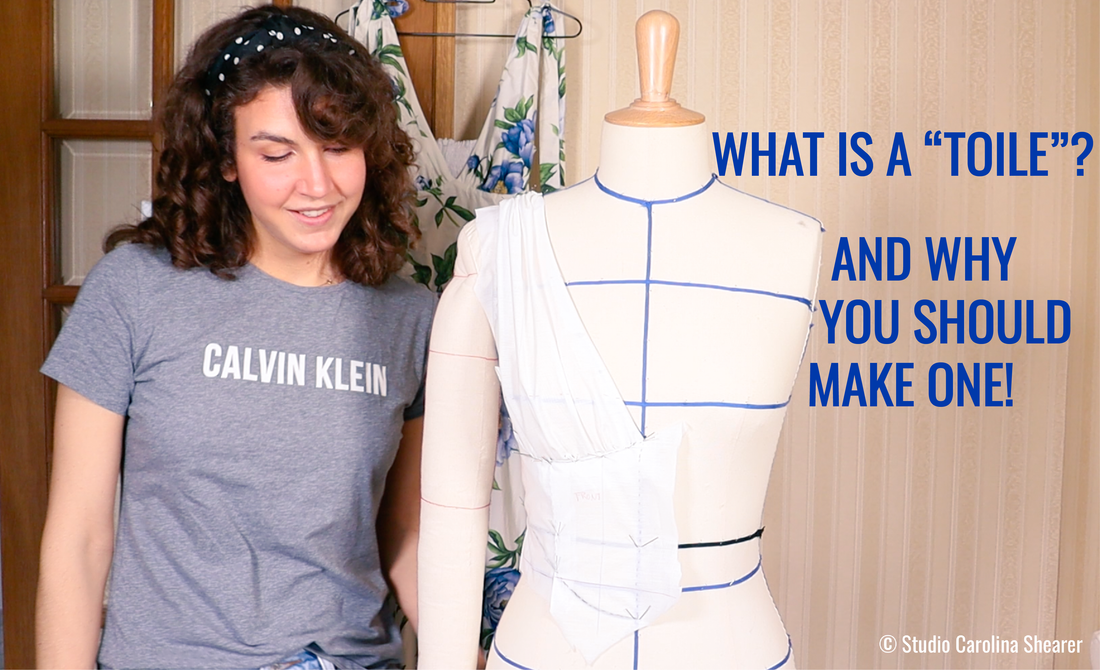You might have also heard it being called a mock-up, prototype, sample garment or even muslin. Whatever you call it, making a toile is an absolutely vital part in any garment making process, I would even go so far as to say it is the unsung hero of the sewing room!
When sewing and pattern making, precision is paramount. Every fold, seam, and stitch contributes to the final garment. However, achieving perfection on the first try is a rare feat. And if the fit of your garment is poor, it doesn't matter how neat your seams are. This is why it's not only important to make a toile when drafting your own patterns but also when you sew a purchased pattern drafted by someone else. Whoever made that pattern probably didn't have your specific body shape and measurements as a guide. Even though your measurments might fit a size on their size chart, body proportions and dimensions vary between each and all of us. Meaning that you might have a larger shoulder span or a bust that sits slightly lower than what the pattern was based on. This is why we toile!
What is a Toile?
A toile is essentially a preliminary version of a garment crafted from inexpensive fabric, often muslin or calico. But it should always be a fabric similar to that of the final garment. It serves as a prototype or trial run before cutting into the final, often more expensive fabric. This practice is deeply ingrained in the world of fashion design and dressmaking, allowing creators to test the fit, design, and construction of a garment before committing to the final product.
Why Are Toiles Important?

- Fit Testing: One of the primary purposes of a toile is to test the fit of a garment. Patterns drafted from measurements may look perfect on paper but can often require adjustments when translated into three-dimensional form. By creating a toile, designers and sewists can identify areas where the fit may need tweaking, such as adjusting darts, altering seam placements, or modifying the overall silhouette. This step is especially crucial when working with intricate designs or custom-fit garments. Early toiles should also include lines on the fabric marking the bust, waist, hip, elbow and straight grains of each piece to verify that these points are correctly placed on the pattern compared to the body of the wearer.

- Design Validation: Toiles provide an opportunity to visualize the design in real life. A lot of the time a "Half-Pinning" is the very first toile made of a new design and it's exactly what is sounds like; a pinned together toile of one half of the garment. Toiles allow creators to see how fabric drapes, how seams align, and how the overall proportions work together. Design elements that may have seemed flawless in sketches or digital renderings can sometimes fall short in reality. Making a toile enables designers to make informed decisions about design details, such as pocket placement, collar styles, or sleeve lengths, ensuring the final garment reflects their vision accurately.
-
Construction Practice: Sewing a toile is not only about testing the design but also about practicing construction techniques. It allows sewists to familiarize themselves with the construction process, identify potential challenges, and refine their sewing skills before working with the final fabric. This practice can be particularly beneficial for beginner sewists or when attempting more complex sewing techniques such as pattern matching, inserting zippers, or creating intricate seam finishes.
-
Fabric Conservation: In addition to its practical benefits, creating a toile can also save both time and money in the long run. By testing the pattern and fit with inexpensive fabric first, creators can avoid costly mistakes when working with more expensive materials. It's far better to make adjustments and fine-tune the design and fit on a toile than to risk ruining expensive fabric due to unforeseen issues. I quite often use old bedsheets or curtains to make my toiles, which can easily be found cheap in most thrift stores.

-
Client Collaboration: For professionals working on custom garments, toiles provide an invaluable tool for client collaboration. They offer clients the opportunity to see a preliminary version of their garment, provide feedback, and request modifications before the final piece is constructed. This collaborative process ensures that the final garment meets the client's expectations and requirements, leading to greater satisfaction for both parties.
In conclusion, toiles play a vital role in the sewing and pattern making process, serving as the foundation upon which impeccable garments are built. From refining fit and design to honing construction skills and conserving resources, the benefits of creating a toile are manifold. So, the next time you embark on a sewing project, remember the importance of the toile—it might just be the key to achieving the professional looking results you've been working towards.
Now toile away to your heart's content and happy sewing,Carolina <3

